
WR 148 is a spectroscopic binary in the constellation Cygnus. The primary star is a Wolf–Rayet star and one of the most luminous stars known. The secondary has been suspected of being a stellar-mass black hole but may be a class O main sequence star.

V1191 Cygni is the variable star designation for an overcontact binary star system in the constellation Cygnus. First found to be variable in 1965, it is a W Ursae Majoris variable with a maximum apparent magnitude 10.82. It drops by 0.33 magnitudes during primary eclipses with a period of 0.3134 days, while dropping by 0.29 magnitudes during secondary eclipses. The primary star, which is also the cooler star, appears to have a spectral type of F6V, while the secondary is slightly cooler with a spectral type of G5V. With a mass of 1.29 solar masses and a luminosity of 2.71 solar luminosities, it is slightly more massive and luminous than the sun, while the secondary is only around 1/10 as massive and less than half as luminous. With a separation of 2.20 solar radii, the mass transfer of about 2×10−7 solar masses per year from the secondary to the primary is one of the highest known for a system of its type.

HO Telescopii is an eclipsing binary star system located in the southern constellation of Telescopium. The maximum apparent visual magnitude of 8.22 is too faint to be visible to the naked eye. The system is located at a distance of approximately 910 light years based on parallax. The combined stellar classification of the system is A7III(m), matching an evolved A-type star that is possibly metallic-lined. The system is around 1.1 billion years old and consists of two stars of similar mass and size.

LQ Andromedae is a variable star in the constellation Andromeda. Its maximum apparent visual magnitude is 6.5, placing it at the limit of the visibility to the naked eye. The brightness, however, drops down to 6.66 with a periodic cycle of roughly 7.44 hours.

WZ Andromedae is an eclipsing binary star in the constellation Andromeda. Its maximum apparent visual magnitude is 11.6, but drops down to 12.00 during the main eclipse which occurs roughly every 16.7 hours.

AB Andromedae is a binary star in the constellation Andromeda. Paul Guthnick and Richard Prager discovered that the star is an eclipsing binary in 1927. Its maximum apparent visual magnitude is 9.49 but shows a variation in brightness down to a magnitude of 10.46 in a periodic cycle of roughly 8 hours. The observed variability is typical of W Ursae Majoris variable stars, so the two stars in this system form a contact binary.

AD Andromedae is an eclipsing binary in the constellation Andromeda. Its maximum apparent visual magnitude is 11.2, but it shows a decrease of 0.62 magnitudes during the main eclipse and 0.58 during the secondary one. It is classified as a Beta Lyrae variable star with a period of almost one day.

BX Andromedae is an eclipsing binary star in the constellation Andromeda. Its maximum apparent visual magnitude is 8.87. Within a cycle of approximately 14.6 hours, the brightness drops down to a magnitude of 9.53 during the main eclipse, and to a magnitude of 9.12 during the secondary one. It is classified as a Beta Lyrae variable.

CC Andromedae is a variable star in the constellation Andromeda. It is a pulsating star of the Delta Scuti type, with an apparent visual magnitude that varies between 9.19 and 9.46 with a periodicity of 3 hours.
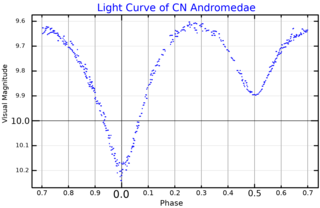
CN Andromedae is an eclipsing binary star in the constellation Andromeda. Its maximum apparent visual magnitude is 9.62 and drops down to a minimum of 10.2 during the main eclipse. It is classified as a Beta Lyrae variable with a period roughly of 0.4628 days.
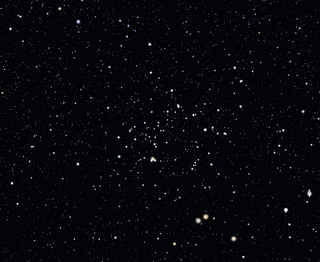
DS Andromedae is an eclipsing binary star in the constellation Andromeda and a member of the open cluster NGC 752. Its maximum apparent visual magnitude is 10.44, but drops down to 10.93 during the main eclipse and to 10.71 during the secondary one.
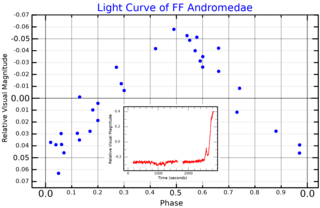
FF Andromedae is a spectroscopic binary in the constellation Andromeda. It has a typical apparent visual magnitude of 10.4, but undergoes flare events that can increase its brightness by about a magnitude.

HN Andromedae is a variable star in the constellation Andromeda. Its apparent visual magnitude varies between 6.67 and 6.76 in a cycle of 69.51 days. It is classified as an α2 Canum Venaticorum variable.

KX Andromedae is a spectroscopic binary star in the constellation Andromeda. Its apparent visual magnitude varies between 6.88 and 7.28.
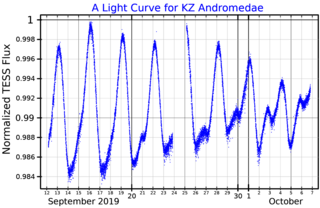
KZ Andromedae is a double lined spectroscopic binary in the constellation Andromeda. Its apparent visual magnitude varies between 7.91 and 8.03 during a cycle slightly longer than 3 days.

QR Andromedae is an eclipsing binary star in the constellation Andromeda. Its maximum apparent visual magnitude is 12.16, but its light curve shows clearly eclipsing events where its brightness can drop to a magnitude of 13.07. This leads to its classification as an Algol variable star.
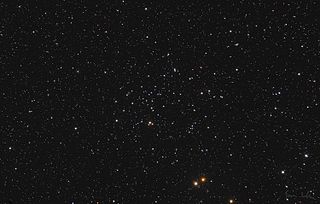
QX Andromedae is an eclipsing binary in the constellation Andromeda. It varies from a maximum apparent visual magnitude of 11.28 to a minimum of 11.50. Since it is impossible to specify the onset time of the eclipses, it is classified as a W Ursae Majoris variable star. It is also observed as an X-ray source and is a member of the open cluster NGC 752.

V455 Andromedae is a dwarf nova in the constellation Andromeda. It has a typical apparent visual magnitude of 16.5, but reached a magnitude of 8.5 during the only observed outburst.

WR 133 is a visually moderately bright Wolf-Rayet star. It is a spectroscopic binary system containing a Wolf-Rayet primary and a class O supergiant secondary. It is in the constellation of Cygnus, lying in the sky at the centre of the triangle formed by β and γ Cygni, near η Cygni. It is the brightest member of the sparse open cluster NGC 6871.

VV Ursae Majoris is a binary star system in the northern circumpolar constellation of Ursa Major, abbreviated VV UMa. It is a variable star system with a brightness that cycles around an apparent visual magnitude of 10.19, making it too faint to be visible to the naked eye. The system is located at a distance of approximately 1,500 light years based on parallax measurements.





















